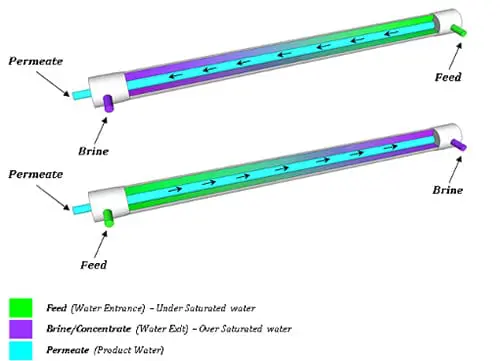HOW ROTEC’S EXCLUSIVE RETROFIT SOLUTION ENHANCES WATER RECOVERY AND OPTIMIZES DESALINATION
THE FRESH WATER SCARCITY NEED
Today, there are millions of desalination plants in the world that have been built over the past 20-25 years, desalinating brackish water or recycling municipal and industrial effluents for a variety of uses and applications.
The vast majority of these facilities operate at a very low efficiency reaching a recovery rate of only 70-80 percent and in many cases much less than that.
Due to the growing need for potable and industrial water purposes all over the world, there is a need to increase global production capacity, which. can be achieved either by building additional desalination plants or by increasing the utilization / production of existing desalination plants.
However, construction of new desalination plants is costly, requires expensive environmental resources and takes a long time. Another challenge is that increasing production in existing desalination plants is not possible in most cases, due to process and/or engineering barriers that do not enable an increase in the recovery rate.
This is where ROTEC fits in with its innovative Flow Reversal technology (FR-RO) and the possibility of implementing it in existing desalination plants – the retrofit solution.
ROTEC’S RETROFIT SOLUTION
ROTEC’s exclusive retrofit solution works with existing RO desalination systems to help improve the recovery rate of medium and large operational facilities. It’s able to transform an under-performing asset to one that delivers one of the highest performing metrics in the industry. Using patented Flow Reversal (FR-RO) technology facilities can:
- Reduce the required volume of rejected brine which needs further
treatment - Improve the recovery rate saving feed water
- Increase yield on product water
FLOW REVERSAL – THE GOLD STANDARD OF WATER DESALINATION TECHNOLOGY
ROTEC’s proprietary Flow Reversal is designed to prevent the common phenomenon of mineral scaling in membrane desalination, which can lead to membrane plugging and lowered recovery rates and an increase in the frequency of cleaning required, which can reduce a membrane’s life span.
By implementing design tweaks in standard RO desalination systems, ROTEC’s FR-RO technology helps prevent scaling – even at high recoveries. By switching the flow direction periodically of the saline stream, scale is swept away before it has time to form on any membrane surfaces.
Unlike anti-scalant alone, you can achieve higher-recovery rates by dictating the frequency of switching according to the time it takes for a supersaturated solution in the concentrate to grow a population of scale particles that can allow continued scale growth. By using the effectively under-saturated feed to sweep away the nascent scale particles in the concentrate before they exceed a critical size, extensive precipitation is prevented. This method enables much higher recovery rates to be achieved in comparison with anti-scalant alone.
under-saturated feed to sweep away the nascent scale particles in the concentrate before they exceed a critical size, extensive precipitation is prevented. This method enables much higher recovery rates to be achieved in comparison with anti-scalant alone.

INDUSTRIAL APPLICATIONS
ROTEC made further upgrades to its Flow Reversal innovation to adjust it to modern desalination settings. These are ruled by multi-stage RO frameworks that use a tapered flow arrangement of pressure vessels (PVs) to maintain correct hydraulic flows in the sequential stages.
Individual blocks can be repositioned between each stage to help prevent fouling of colloids, biomaterials, and organics, while also helping to lower the intensity of salts at the membrane surface.



SOLUTION IMPLEMENTATION PHASES
- First stage would be visiting the client for site survey. An in-depth study of the existing system is related to this phase.
- The design, procurement and construction of the equipment is done early on in our workshop without interrupting the existing system. Most retrofitting-related equipment is related to piping, valves and controls.
- The equipment arrives at the site and is organized on site when there is only minimal disruption to the existing system. This stage may take up to 2 weeks.
- Membranes replacement is recommended in case the existing membranes are in a bad used condition
- Final connection of the new equipment to the existing one, dry and wet system testing and gradual operation of the integrated system are done. This process requires the system to be disabled for up to 4 days.
- Maximal performance is achieved via gradual increase in recovery rate while checking the integrity of the equipment.
- Accompanying the project continuously and issuing performance reports.
Note: Upgrading can be done during a periodic overhaul of the system, so it may not require time for itself
SUCCESSFUL TRACK RECORD

Note:
- Specific Energy consumption is about the same
- Chemicals consumption is equal or less
- CIP frequency is less up to 50%
- System downtime for implementation purposes is up to 4 days
RETROFITTED SYSTEM BEFORE AND AFTER
ORIGINAL DESIGN: 75% RR
AFTER RETROFITTING: 90% RR
SUMMARY
Retrofit Benefits at a Glance
ROTEC’s unique solution makes it the only company capable of providing retrofit of existing plants at the highest recovery rate. The solution enables plants to enhance their performance, save water and costs, while simultaneously reducing their eco-footprint with minimal disruption to operations.
Highlights in Numbers
• Fallback redundancy of 100%
• Ultra-high recovery up to 98%
• Unique retrofit ability boosts recovery up to 20%
• Brine volume reduction up to 60%
ECONOMIC VIABILITY
ROTEC’s unique technology allows plants to extend the life of their existing infrastructure and increase their performance with inherent resistance to scaling and biofouling, reducing – CIP frequency and chemical consumption – all risk-free. The cost of performing retrofit is significantly lower than replacing an existing system with a larger system. In general, the greater the capacity in an existing system, the higher the ratio of the retrofit’s capital cost to building a new system.
The expenses for carrying out the retrofit can be deducted from the operating expenses of the plant, and thus make it easier for decision makers, and shorten times.
